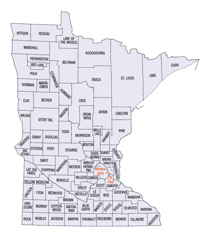Minnesota Counties
There are eighty-seven Counties in Minnesota. On October 27, 1849 nine large Minnesota Counties were created. Among them were Benton, Dahkotah, Itasca, Ramsey, Mahkahta, Pembina, Wabashaw, Washington, and Wahnata. Of those Benton, Dakota, Itasca, Ramsey, Wabasha, and Washington still exist as their original name. With the creation of Kittson County on March 9, 1878, Pembina County no longer existed. When Minnesota was organized as a state, 57 of the present 87 Counties were established. The last county to be created was Lake of the Woods County in 1923Scott County, Minnesota
Scott County Education, Geography, and History
Scott County is a county located in the state of Minnesota. Based on the 2010 census, the population was 129,928. Its county seat is
Shakopee. The county was organized in 1853 and named in honor of General Winfield Scott.
Scott County is included in the Minneapolis-St. Paul-Bloomington, MN-WI Metropolitan Statistical Area.
Etymology - Origin of Scott County Name
Named for General Winfield Scott, commander in chief, US Army, 1841-61; commander of American forces, Mexican War, 1847. On his recommendation, the name of Ft. St. Anthony was changed to Ft. Snelling in 1825.
Demographics:
County QuickFacts: CensusBureau Quick Facts
Scott County History
Scott County was first inhabited by two bands of the Santee Sioux (Dakota) Indians, the Mdewakanton and Wahpeton. They
lived a semi-nomadic life that followed a seasonal cycle. They gathered food, hunted, fished, and planted corn. In the summer the Dakota
villages were occupied but in the winter the groups separated for hunting. They had many permanent villages along the Minnesota River. They
had many trails leading to these settlements and to the Red River Valley in the North, and the Prairie du Chien to the Southeast. These trails
were later used by the fur traders and settlers, and were known as the "ox cart trails." The area of Scott County, as well as much of southern
Minnesota, was opened for settlement by two treaties signed at Mendota and Traverse des Sioux, in 1851 and 1853. These treaties removed the
Dakota Indians to reservations in upper Minnesota.
Scott County was established and organized by an Act passed in the legislature on March 5, 1853. The 369-square-mile (960 km2) county was
named after General Winfield Scott.
Geography: Land and Water
As reported by the Census Bureau, the county has a total area of 368 square miles (950 km2), of which 356 square miles (920 km2) is land
and 12 square miles (31 km2) (3.2%) is water. It is the third-smallest county in Minnesota by land area and second-smallest by total area.
The Minnesota River is the county's boundary in both the north and the west. The broad river valley juts through glacial sediment into some of
the oldest rock known. Now mostly farmland, it was an oak savanna and a mixture of grass and clusters of trees that grew parallel to the river
valley. The savanna bordered the "Big Woods", a "closed-forest savanna" that covered most of Minnesota before it was logged in the mid-19th
century. Scott is one of 17 Minnesota savanna counties with more savanna soils than either forest or prairie soils.
Neighboring Counties
Bordering counties are as follows:
- Hennepin County (north)
- Dakota County (east)
- Rice County (southeast)
- Le Sueur County (southwest)
- Sibley County (west)
- Carver County (northwest)
Education







